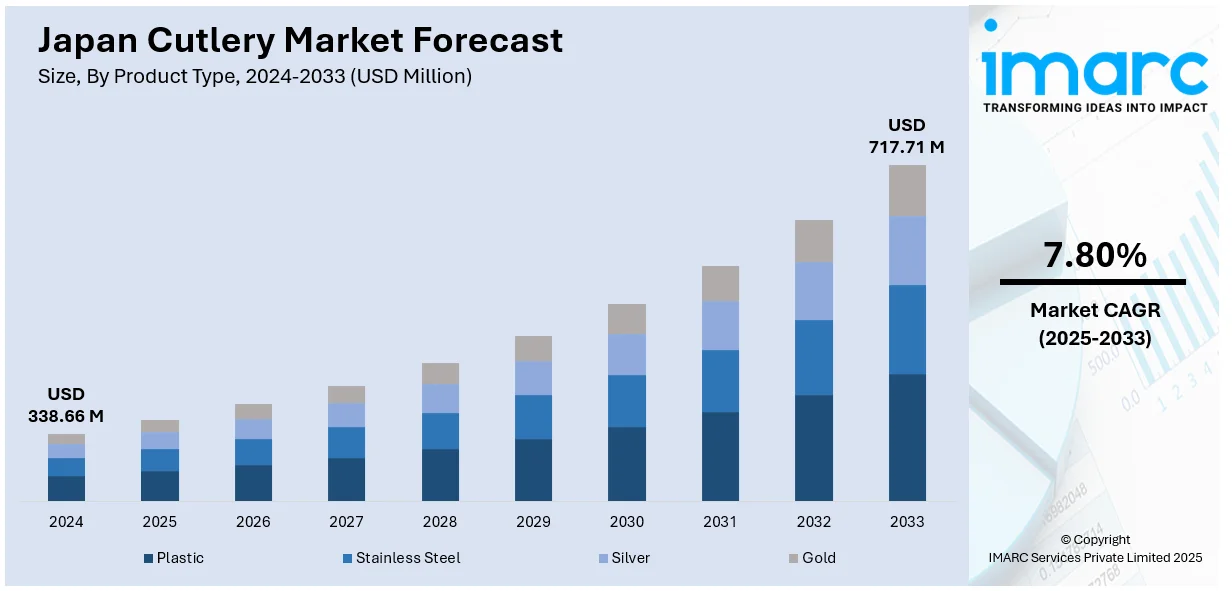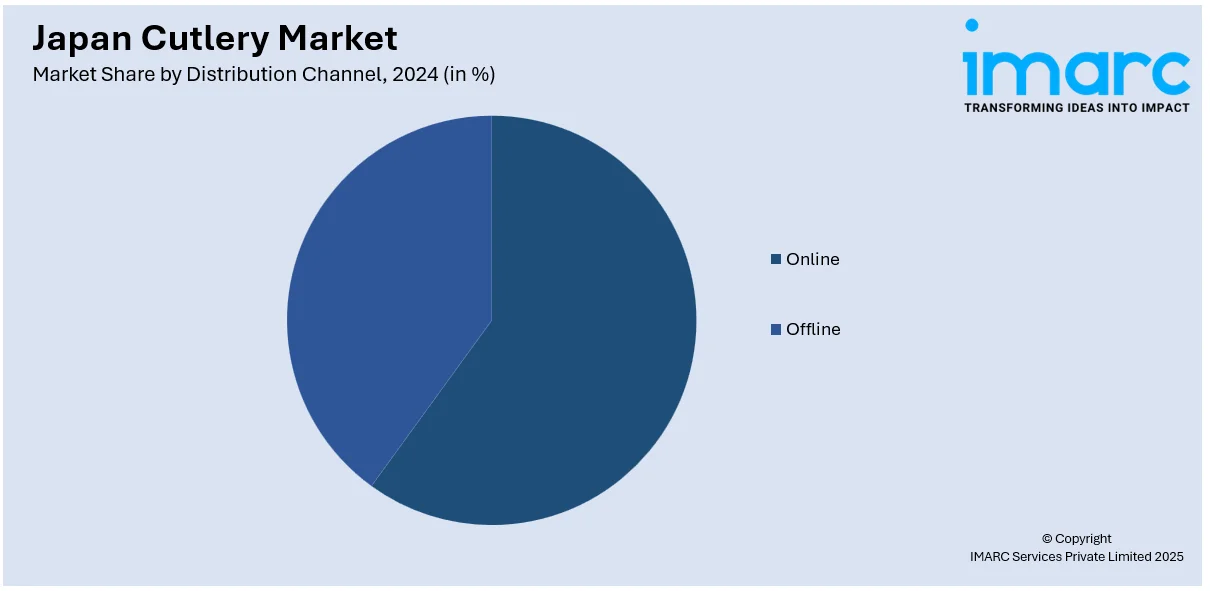
Japan Cutlery Market Size, Share, Trends and Forecast by Product Type, Distribution Channel, Application, and Region, 2025-2033
Japan Cutlery Market Overview:
The Japan cutlery market size reached USD 338.66 Million in 2024. Looking forward, IMARC Group expects the market to reach USD 717.71 Million by 2033, exhibiting a growth rate (CAGR) of 7.80% during 2025-2033. The market is driven by the harmonious blend of age-old craftsmanship and cutting-edge technology to achieve higher precision and durability. Minimalist and functional designs with an air of simplicity and elegance coupled with high performance are gaining in popularity in the market. In addition, eco-friendly manufacturing practices like the use of recycled materials and eco-friendly packaging are becoming highly popular with the growing need for eco-friendly products, contributing to Japan cutlery market share.
|
Report Attribute
|
Key Statistics
|
|---|---|
|
Base Year
|
2024
|
|
Forecast Years
|
2025-2033
|
|
Historical Years
|
2019-2024
|
| Market Size in 2024 | USD 338.66 Million |
| Market Forecast in 2033 | USD 717.71 Million |
| Market Growth Rate 2025-2033 | 7.80% |
Japan Cutlery Market Trends:
Focus on Historic Craftsmanship and Contemporary Innovation
Japanese knives are famous for their unparalleled craftsmanship, a heritage that prevails in shaping the industry's development. Talented craftsmen uphold centuries-old processes like hand hammering, differential hardening, and painstaking sharpening to create blades of legendary sharpness and resilience. These timeless techniques guarantee that each item carries a distinctive combination of precision and artistry, prized both at home and abroad. Together with this respect for tradition, contemporary innovation in metallurgy and design reinforces product performance. High-quality stainless steel alloys reduce corrosion and edge wear, and ergonomic handle forms provide comfort during application. This combination of traditional craftsmanship and technological sophistication enables Japanese cutlery to continue to expand its share of markets around the world, further solidifying its reputation as a beacon of quality and dependability. For instance, in October 2023, Kyocera introduced the Chowa knife series, marking 40 years of knife production by fusing Japanese craftsmanship with Z212 zirconia ceramic blades for durable sharpness and ergonomic design. Moreover, such blending of tradition and innovation is what attracts consumers in search of products that mix beauty, precision, and functional performance.

Increasing Demand for Minimalist and Functional Styles
One key trend influencing the Japan cutlery market is the increasing popularity of minimalist and functional styles. This is part of a larger cultural shift toward simplicity, elegance, and functionality in day-to-day objects. Customers are attracted to cutlery with clean lines, simple designs, and neutral colors that harmonize well with contemporary kitchens. Minimalism is not a hindrance to usability but rather an improvement by prioritizing ergonomics and maintenance simplicity. Matte finishes and underlying textures are features that give such products their luxury look, creating a sense of sophistication in kitchen spaces. For example, in October of 2023, Yamatani Industry, Tadafusa, and Kaneko Sogyo introduced a Santoku knife made in Sanjo with an SLD steel blade and traditional NAGURI-processed wenge handle for high-end functionality and design. Furthermore, this design ethos finds appeal in modern lifestyles, where convenience and adaptability are the values that consumers seek in cooking equipment. The marriage of minimalism with excellence in craftsmanship in knives finds appeal with both professional cooks and home chefs alike, propelling the consistent expansion of Japan cutlery as part of the fabric of culinary culture.
Convergence of Sustainable and Eco-Friendly Production Methods
Sustainability has played a bigger role in Japanese cutlery production as consumers and producers have become more environmentally conscious. Reducing its ecological footprint has been achieved through the utilization of recycled metals, energy-saving forging methods, and the generation of little waste during production. In addition to this, the long lifespan and strength of Japanese cutlery promote the move away from disposable eating utensils toward sustainable consumption. Innovations in packaging are also in play, with an emphasis on recyclable materials and minimizing plastics usage. These environmentally friendly practices not only harmonize with world environmental aspirations but also increase the global appeal of Japanese cutlery to a socially responsible consumer market segment. Through the integration of green principles with time-honored craftsmanship and contemporary design, the sector promotes ongoing development and places itself at the forefront of sustainable, high-quality kitchenware manufacturing.
Japan Cutlery Market Segmentation:
IMARC Group provides an analysis of the key trends in each segment of the market, along with forecasts at the country and regional levels for 2025-2033. Our report has categorized the market based on product type, distribution channel, and application.
Product Type Insights:
- Plastic
- Stainless Steel
- Silver
- Gold
The report has provided a detailed breakup and analysis of the market based on the product type. This includes plastic, stainless steel, silver, and gold.
Distribution Channel Insights:

- Online
- Offline
A detailed breakup and analysis of the market based on the distribution channel have also been provided in the report. This includes online and offline.
Application Insights:
- Household
- Public Consumption Restaurant
- High-end Restaurant
The report has provided a detailed breakup and analysis of the market based on the application. This includes household, public consumption restaurant, and high-end restaurant.
Regional Insights:
- Kanto Region
- Kansai/Kinki Region
- Central/ Chubu Region
- Kyushu-Okinawa Region
- Tohoku Region
- Chugoku Region
- Hokkaido Region
- Shikoku Region
The report has also provided a comprehensive analysis of all the major regional markets, which include Kanto region, Kansai/Kinki region, Central/Chubu region, Kyushu-Okinawa region, Tohoku region, Chugoku region, Hokkaido region, and Shikoku region.
Competitive Landscape:
The market research report has also provided a comprehensive analysis of the competitive landscape. Competitive analysis such as market structure, key player positioning, top winning strategies, competitive dashboard, and company evaluation quadrant has been covered in the report. Also, detailed profiles of all major companies have been provided.
Japan Cutlery Market News:
- In April 2025, Jayger unveiled its 67-layer Damascus premium Japanese chef knife series made from VG-10 and AUS-10 steel. Blending classic forging with ergonomic pakka-wood handles, the blades provide superior sharpness, balance, and resilience. The series has styles such as Gyuto, Santoku, Nakiri, Petty, and Yanagiba, suitable for every kitchen task.
- In April 2024, Made In introduced the Damascus Bunka knife, its first Japanese-made item. Featuring 66 layers of Damascus steel and a cobalt-infused VG-10 core, the ultrasharp, ultralight knife is built with durability, flex, and ergonomic design perfect for sharp slicing, dicing, and daily meal prep.
Japan Cutlery Market Report Coverage:
| Report Features | Details |
|---|---|
| Base Year of the Analysis | 2024 |
| Historical Period | 2019-2024 |
| Forecast Period | 2025-2033 |
| Units | Million USD |
| Scope of the Report |
Exploration of Historical Trends and Market Outlook, Industry Catalysts and Challenges, Segment-Wise Historical and Future Market Assessment:
|
| Product Types Covered | Plastic, Stainless Steel, Silver, Gold |
| Distribution Channels Covered | Online, Offline |
| Applications Covered | Household, Public Consumption Restaurant, High-end Restaurant |
| Regions Covered | Kanto Region, Kansai/Kinki Region, Central/Chubu Region, Kyushu-Okinawa Region, Tohoku Region, Chugoku Region, Hokkaido Region, Shikoku Region |
| Customization Scope | 10% Free Customization |
| Post-Sale Analyst Support | 10-12 Weeks |
| Delivery Format | PDF and Excel through Email (We can also provide the editable version of the report in PPT/Word format on special request) |
Key Questions Answered in This Report:
- How has the Japan cutlery market performed so far and how will it perform in the coming years?
- What is the breakup of the Japan cutlery market on the basis of product type?
- What is the breakup of the Japan cutlery market on the basis of distribution channel?
- What is the breakup of the Japan cutlery market on the basis of application?
- What is the breakup of the Japan cutlery market on the basis of region?
- What are the various stages in the value chain of the Japan cutlery market?
- What are the key driving factors and challenges in the Japan cutlery?
- What is the structure of the Japan cutlery market and who are the key players?
- What is the degree of competition in the Japan cutlery market?
Key Benefits for Stakeholders:
- IMARC’s industry report offers a comprehensive quantitative analysis of various market segments, historical and current market trends, market forecasts, and dynamics of the Japan cutlery market from 2019-2033.
- The research report provides the latest information on the market drivers, challenges, and opportunities in the Japan cutlery market.
- Porter's five forces analysis assist stakeholders in assessing the impact of new entrants, competitive rivalry, supplier power, buyer power, and the threat of substitution. It helps stakeholders to analyze the level of competition within the Japan cutlery industry and its attractiveness.
- Competitive landscape allows stakeholders to understand their competitive environment and provides an insight into the current positions of key players in the market.
Need more help?
- Speak to our experienced analysts for insights on the current market scenarios.
- Include additional segments and countries to customize the report as per your requirement.
- Gain an unparalleled competitive advantage in your domain by understanding how to utilize the report and positively impacting your operations and revenue.
- For further assistance, please connect with our analysts.
 Request Customization
Request Customization
 Speak to an Analyst
Speak to an Analyst
 Request Brochure
Request Brochure
 Inquire Before Buying
Inquire Before Buying




.webp)




.webp)












